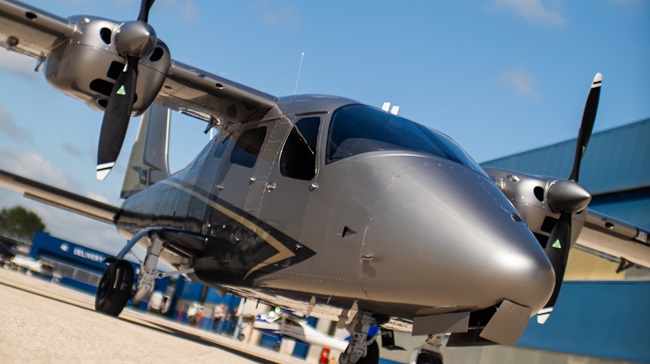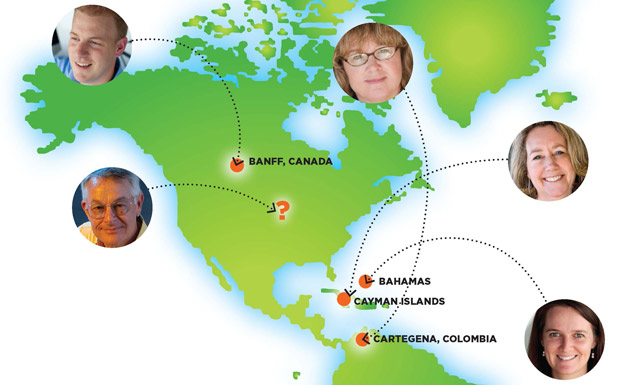
The Bahamas and Cayman Islands are the ideal flying destinations for most AOPA staffers who tried the AOPA Perfect Destinations online quiz, although there were a few outliers.
“As a former surfer girl, any place on a beach is for me,” said Julie Summers Walker, AOPA director of publications and managing editor, who got the Cayman Islands as her recommended destination.
“Staniel Cay, Bahamas,” said Alyssa J. Miller, AOPA director of eMedia and online managing editor, who has flown GA to the islands on post-hurricane relief missions. “I’ll take that!”
Flight Training Editor Ian Twombly, an alpine skier, was directed to a cooler climate: Banff in Alberta, Canada. But Twombly claimed he didn’t know how to answer one of the quiz questions based on the TV show Green Acres, which aired from 1965 to 1971.
“I’ve never seen Green Acres,” the 30-something Twombly said. Not even on TV Land.
Senior Editor Alton Marsh, who is old enough to remember Green Acres stars Eddie Albert and Eva Gabor, also took issue with some of the quiz questions. Marsh said he doesn’t take part in alpine, cross-country, water, or jet skiing, so the question about what type of skiing he preferred was irrelevant. The curmudgeonly Marsh also took the quiz to task for failing to offer a none-of-the-above selection for alcoholic beverages, and said he needed a shorter option than 15 minutes for the time he was willing to sit poolside.
Sounds like Marsh won’t be sipping umbrella drinks by the pool if he follows the quiz advice to fly to the Bahamas.
Flight Training Technical Editor Jill Tallman got the most exotic destination—Cartagena, Colombia. Tallman said she was formerly unaware of the picturesque city on the Caribbean coast.
“I had never heard of it,” she said, “but since I love beaches, it seems to be on the mark.”
Web: www.aopa.org/apps/quizzes/?quiz=2
First Look: Shared history inspires Breitling partnership
Limited edition timepiece available
 Breitling, the Swiss watch company, with a deep aviation history will launch a special edition timepiece in honor of the seventy-fifth anniversary of AOPA. This exclusive limited edition Navitimer features the AOPA logo on the dial, similar to the version launched in 1954. On the caseback, AOPA members can have their name and membership number engraved to commemorate the anniversary and their personal aviation commitment.
Breitling, the Swiss watch company, with a deep aviation history will launch a special edition timepiece in honor of the seventy-fifth anniversary of AOPA. This exclusive limited edition Navitimer features the AOPA logo on the dial, similar to the version launched in 1954. On the caseback, AOPA members can have their name and membership number engraved to commemorate the anniversary and their personal aviation commitment.
A portion of proceeds from the sale of this commemorative edition watch will go to help grow the pilot population through the Breitling Aviation Scholarship Fund, which will offer flight training support for those interested in learning to fly. The AOPA Foundation will administer this scholarship program, available to aviation enthusiasts of all ages.
“The support from AOPA over the years represents a key part of Breitling’s aviation heritage,” said Breitling USA President Thierry Prissert, “As the largest aviation organization of its kind, AOPA is a diverse community of pilots, and Breitling is thrilled to be recognizing this significant anniversary with a commemorative timepiece for AOPA members that contributes to such a worthy cause.”
The partnership between AOPA and Breitling spans more than 60 years, when AOPA selected the Breitling Navitimer as its official watch in 1954. Early in its history, Breitling was recognized as an aviator’s chronograph, notably providing on-board chronographs for World War II aircraft. The Navitimer, with a circular slide rule that enables it to perform all necessary navigation-related calculations, is the ideal pilot’s chronograph.
“We are delighted that Breitling has revived a very special aviation tradition,” said AOPA President Mark Baker. “This is a truly unique timepiece that reflects on the proud history of AOPA and general aviation while ensuring a strong future by supporting flight training scholarships to help create the next generation of pilots.”
Family business
A specialist of technical watches, Breitling played a crucial role in the development of the wrist chronograph. Léon Breitling founded the company in 1884 in St. Imier, Switzerland, and devoted himself to the exclusive and demanding field of chronographs and timers. Breitling developed the first independent chronograph pushpiece in 1915 and then added the second pushpiece in 1934 to complete the final configuration of the modern chronograph. In 1969, the brand introduced the first self-winding chronograph movement. Today Breitling is the world’s only major watch brand to equip all its models with chronometer-certified movements, the ultimate token of precision. Breitling is one of the rare companies to produce its own mechanical chronograph movement, entirely developed and manufactured in its workshops. This family business is also one of the last remaining independent Swiss watch brands, celebrating its 130-year anniversary in 2014.
Visit the website to customize your personal timepiece.
Do you own an original AOPA Navitimer? Tell us its history and how you came to own it ([email protected]). We will publish some of the stories in future issues.
News
SMA building larger diesel engines
Developing two new, more powerful variants
Thomas A. Horne
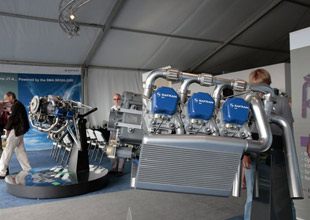 SMA isn’t standing still. Now that the first of its turbo-diesel engines—the four-cylinder, 230-horsepower SR305-230E—has been chosen to power Cessna’s new Jet A-powered Skylane JT-A, the company announced a project to develop two new, more powerful variants.
SMA isn’t standing still. Now that the first of its turbo-diesel engines—the four-cylinder, 230-horsepower SR305-230E—has been chosen to power Cessna’s new Jet A-powered Skylane JT-A, the company announced a project to develop two new, more powerful variants.
Worldwide, there are a total of 45 airplanes flying with the SR305-230E, and SMA has run these engines to TBO on test stands. After the tests were complete, a disassembly and inspection of these engines showed no anomalies. On the other hand, a Skylane JT-A suffered an engine failure during its flight test phase. The problem was traced to burrs on the SR305’s crankshaft—burrs caused by manufacturing defects that have since been corrected at the factory.
The first follow-on engine is being designed to put out between 260 horsepower and 285 horsepower. Under the SR305-XX project name, SMA plans to use the same technology of its predecessor and adapt it for higher takeoff and cruise power. Currently several prototype demonstrators are undergoing endurance tests.
The other engine is the SR460, designed to develop between 330 horsepower and 400 horsepower. This six-cylinder turbo diesel has dual turbochargers and is being pitched to manufacturers of single- and multiengine piston airplanes, as well as helicopters. Like the SR305 engine, an electronic control unit (ECU) optimizes engine starts, provides maximum power according to ambient conditions, and controls engine speed at low power levels. At high power levels, the diesel engine’s compression-ignition characteristics sustain combustion. There will also be a mechanical backup to the ECU.
The SR460 will maintain full power up to its critical altitude of 10,000 feet mean sea level, SMA said, and will have a TBO greater than 2,000 hours. So far, two to three airframe manufacturers have expressed interest in the SR460, SMA said.
Email [email protected]
New four-seater from Italy
Seven-stop tour under way
Thomas A. Horne
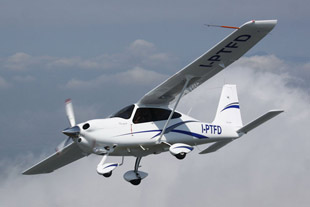 Tecnam’s new four-seat, 133-knot, 180-horsepower model P2010 has taken one big step toward FAA certification under FAR Part 23. The Italian company said that the airplane had earned EASA (European Aviation Safety Agency) certification. By October, 15 P2010s were to be in the hands of owners.
Tecnam’s new four-seat, 133-knot, 180-horsepower model P2010 has taken one big step toward FAA certification under FAR Part 23. The Italian company said that the airplane had earned EASA (European Aviation Safety Agency) certification. By October, 15 P2010s were to be in the hands of owners.
To date, a worldwide total of 35 to 40 P2010 orders had been placed, with 10 of those coming from the United States, Tecnam officials said. A $5,000 deposit is required to secure a delivery position for the $385,000 airplane, which is powered by a Lycoming IO-360-M1A engine—the most modern, lightest IO-360 ever built, according to a Lycoming spokesman. The P2010 can be ordered with a variety of avionics packages, among them the Garmin G500 or G1000 avionics packages.
As this was written copies of the new aircraft were on the way to the company’s new showroom, delivery center, and maintenance training facility in Sebring, Florida. “After that, the FAA should take about one month to perform all the tests necessary to demonstrate conformity with U.S. rules,” Tecnam official Shannon Yaeger said. “And after it’s certified we’ll be taking the airplane on a seven-stop tour around the United States.”
Email [email protected]
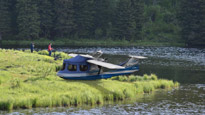
oshkosh news
Diesel Skyhawk.In 2015 you can purchase a 155-horsepower diesel engine Cessna 172 “Turbo Skyhawk” JT-A for $435,000. A Continental CD-155 engine powers it, and propels the aircraft farther and faster (131 knots true airspeed) than an avgas-powered 172.
Amphib surfaces. In 2017 you can build an amphibious two-seater from MVP Aero for $169,000 (minus paint) and by 2018 it will be available as an Experimental Light Sport aircraft, followed by offering the same aircraft in 2019 as a $189,000 factory built Light Sport.
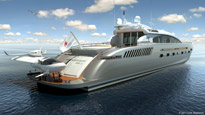 More and more amphibs. Icon’s A5 amphibious light sport aircraft, many years in the making, is expected to reach customers in May 2015. The first production $189,000 A5 flew in July and faces competition in five years from the $189,000 MVP Aero. Same price? What a coincidence. Also present at Oshkosh was the $400,000 Lisa Akoya two-seat amphib that fits on the fantail of your yacht. You do have a fantail, right?
More and more amphibs. Icon’s A5 amphibious light sport aircraft, many years in the making, is expected to reach customers in May 2015. The first production $189,000 A5 flew in July and faces competition in five years from the $189,000 MVP Aero. Same price? What a coincidence. Also present at Oshkosh was the $400,000 Lisa Akoya two-seat amphib that fits on the fantail of your yacht. You do have a fantail, right?
Angle of attack. Safe Flight has a $1,495 angle of attack indicator that not only helps you avoid aerodynamic stalls, but shows the best angles to fly for maximum rate and angle of climb, range, and endurance (see “Safe Flight’s New AOA System,” page 56).
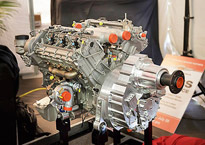 Diesels for all. Continental Motors Group is developing a 310-horsepower diesel aircraft engine. SMA of France is developing two diesel engines of 250 to 400 horsepower. American Champion Aircraft, after a decade of waiting on other diesel companies to develop an engine, has decided to put an Austro diesel engine on the Scout.
Diesels for all. Continental Motors Group is developing a 310-horsepower diesel aircraft engine. SMA of France is developing two diesel engines of 250 to 400 horsepower. American Champion Aircraft, after a decade of waiting on other diesel companies to develop an engine, has decided to put an Austro diesel engine on the Scout.
Volunteers 5,400 (compared to around 5,000 in 2013).
All under control About 6,000 traffic cones were set up. There were nine miles of temporary fencing set up.
Total attendance Estimated to be up 5 percent over 2013, pending final counts, and up 20 percent for Saturday. More than 8,000 aircraft arrived at OSH during the week, up 1,000 over 2013. More than 10,000 aircraft arrived in all, including the regional relievers.
When you gotta go There were 1,000 porta-potties on the field, and 2 million sheets of toilet paper used to stock them.
See all EAA AirVenture 2014 news online. The most viewed EAA AirVenture story on AOPA Online was AOPA’s reimagined Cessna 150/152.
Your personal jet
Sonex jet ready for customers
Alton K. Marsh
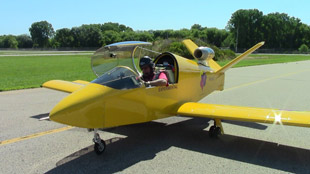 The 170-knot SubSonex Personal Jet kitplane is ready for customers after completing a series of test flights earlier this year. Cruises speeds range from 160 knots true airspeed (at 10,000 feet) to 170 knots, depending on altitude, although full throttle gets you above 200 knots at sea level.
The 170-knot SubSonex Personal Jet kitplane is ready for customers after completing a series of test flights earlier this year. Cruises speeds range from 160 knots true airspeed (at 10,000 feet) to 170 knots, depending on altitude, although full throttle gets you above 200 knots at sea level.
The Experimental/Amateur-Built compliant kit sells for $130,000 including engine. A more complete kit eligible only for Experimental Exhibition certification sells for $135,000, minus avionics and paint. Depositors who put up $10,000 for an early place in line were offered the opportunity to give firm orders for 2014 kit production.
Once the early movers have weighed in, the general public will be able to place orders for deliveries in 2015. The SubSonex will be sold as a quick-build kit that includes “almost everything required to fly with the exception of avionics and paint,” the company said. It is powered by the PBS TJ-100 jet engine with 250 pounds of thrust offered by engine manufacturer První brněnská strojírna Velká Bíteš in Velká Bíteš, Czech Republic, located southeast of Prague.
A video of the third flight posted on YouTube shows the pilot making a hefty pull on the side-mounted control stick to rotate the nose upward to the takeoff position. That is reminiscent of the T-tail Piper Seminole, which requires strong back force on the control yoke to raise the nose during the takeoff run, followed by a quick return to the neutral position once the nose comes up to avoid over-rotating. Control forces required for rotation will be adjusted during the flight testing phase.
Email [email protected]
75 years ago this month
AOPA was founded May 15, 1939.
It is October 1939. The last Polish army has been defeated. The Luftwaffe lost 285 aircraft in the Polish campaign; Poland lost 333 aircraft. Hitler announces his plan to regulate the “Jewish problem,” and the Nazis require Jews to wear the Star of David.
October 1 Winston Churchill calls the Soviets “a riddle wrapped in a mystery inside an enigma.”
October 8 Germany annexes western Poland. The first Jewish ghetto in Nazi-occupied Europe is established in Poland.
October 11 Albert Einstein informs President Franklin D. Roosevelt of the possibilities of an atomic bomb.
October 14 The German submarine U-47 sinks the British battleship HMS Royal Oak.
October 15 The New York Municipal Airport (later renamed La Guardia Airport) is dedicated.
October 16 The Luftwaffe attacks its first British targets, Royal Navy warships in the Firth of Forth.
October 17 Mr. Smith Goes to Washington premieres in Washington, D.C., starring Jimmy Stewart.
October 22 NBC broadcasts the first televised National Football League game. The Philadelphia Eagles fall to the Brooklyn Dodgers, 23-14.
October 24 Nylon stockings go on sale for the first time anywhere in Wilmington, Delaware.
October 28 A British Spitfire shoots down a German Heinkel He 111 over Scotland.
Giving back: Challenge Air
Changing lives with first flights
Jim Moore
More than 20 years after Rick Amber overcame injuries that he suffered as a U.S. Navy pilot and left him paralyzed, he returned to the cockpit on a mission to share the joy of flight with children facing their own challenges. Challenge Air, the organization that he created, continues that mission.
Maureen Brice Bordelon, the parent of 13-year-old Jonathan who has special needs, is among hundreds flown by volunteer pilots working through Challenge Air, the Texas nonprofit organization Amber launched in 1993. “My husband’s face was beaming as bright as my son’s, and he told me that Jonathan did great,” Bordelon said following a Fly Day event. “When I asked Jonathan what he liked best about being a co-pilot, he looked at me smiling and said, ‘Airplane,’ hugged me tight and added, ‘Hope.’”
Challenge Air Executive Director April Culver counts the flights: more than 800 since 2013, a significant achievement in itself given that the economic downturn forced the organization to lay off virtually the entire staff about three years ago. “We’re doing much better financially,” Culver says, noting that she has been able to advertise for a program assistant to refill one of those lost positions.
Culver and her dedicated volunteers plan to increase the pace, from eight Fly Day events per year up to 12 by 2015—made possible in part by a $10,000 grant from the AOPA Foundation’s Giving Back program. Grants are funded entirely with tax-deductible donations to the AOPA Foundation; those donations, which do not include any AOPA membership dues, supported 10 charitable organizations with various missions in the inaugural round of grants. The program has created positive publicity for GA in media outlets around the country.
Culver said the Giving Back grant helped Challenge Air cover costs such as T-shirts that are given to each participant, along with a set of pilot’s wings. AOPA member pilots have been enthusiastic volunteers, donating their time, skills, and fuel.
“The day was perfect and beyond any expectations I had,” Bordelon said. “Challenge Air, the volunteers, and generous donations made it possible for our little guy and many other children reach for the sky, and—in Jonathan’s words—hope.”
Email [email protected]
Web: www.aopafoundation/givingback
Flying Clubs: The Flying Neutrons
Survival of the fittest
Benét J. Wilson
The Lebanon, Ohio-based Flying Neutrons club, founded in 1952, is a group that has rebounded from a series of events that could have shut it down. The club survived a drop in membership during the global economic recession along with the closing of Blue Ash Airport, its home base, in 2012. The club is now located at Lebanon-Warren County Airport.
The club was founded by engineers from the nearby General Electric engine plant in Evendale, Ohio. “The engineers in 1952 were designing a nuclear aircraft engine for strategic bombers, and the spirit of thoroughness, precision, and innovation you would expect from nuclear aviation engineers continues today,” said President Jim Witte.
The club currently has 100 members; 93 senior members, five junior members, and two Light Sport aircraft members. It has two Cessna 172s, a Piper Arrow, a Piper Cherokee Six, a Cessna 182T, and a Paradise LSA.
The Paradise was owned by Nelda Lane, the widow of Jon Lane, who was responsible for the creation of Lebanon-Warren County Airport. “Both Jon and Nelda were pilots. Following Jon’s death, Nelda became acquainted with the club,” Witte said. “Nelda offered to allow the club to purchase the LSA at a slight discount to show support for the values embodied by the club.”
Email [email protected]
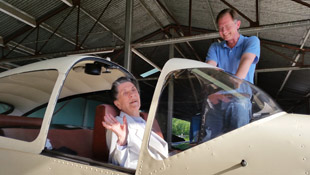 Lid goes flying
Lid goes flying
Gary seem offered a special present to 101-year-old Lid Miles at her birthday party and she took him up on it—a ride in his 1959 Ryan Navion based at Princeton Airport in New Jersey. “Lid loved the ride and she had the controls for a few minutes as we cruised at 2,500 feet on a cool, smooth late summer afternoon,” he said.
Quite often in a story like this, the centenarian reports that it is her or his first airplane ride. Not Lid. She told Seem she is quite familiar with the feel of flying in a single-engine airplane. After all, a friend of hers took her up in 1939! —AKM
Mackinac Island
Greatest Great Lake destination
Thomas B. Haines
In aviation, island adventures abound. Tangier in the East, Catalina in the West, the Florida Keys, San Juan Islands in the Northwest—but few think about the Great Lakes. Put in Bay and Kelleys Island on Lake Erie are two wonderful general aviation friendly destinations that are otherwise only accessible by boat. But the greatest of the Great Lakes island retreats must surely be Mackinac Island.
Situated right at the tip of the Michigan mitten, the island in the Straits of Mackinac seems like a step back in time. Motorized travel on the island is prohibited. Foot, bicycle, and horse-drawn carriages are the only way to get around.
But to get on the island, pilots have awaiting a 3,500-foot paved runway (MCD) maintained by the U.S. Park Service—your tax dollars at work in a good way. Bring your own tiedown and be prepared to pay a landing feet. There is no fuel available, but Mackinac County Airport in nearby St. Ignace, Michigan, can solve that. En route there from the island you’ll get a good look at the famous Mackinac Bridge.
Upon taxing to the island’s ramp, you can ring for a carriage or hike it into town—about a 20-minute walk. There you will find an eclectic collection of hotels, inns, and resorts and restaurants galore. Be sure to stop by Fort Mackinac to hear the tales of the Revolutionary War and the War of 1812. The island is at the strategic confluence of Lake Huron and Lake Michigan and was controlled by the British until well after the American Revolution. History abounds and adventure awaits as you prowl around historic Mackinac Island.
Email [email protected]
If you go:
Mackinac Island Airport (MCD)
906-847-3231
Rental cars: www.aopa.org/cars
Resources: http://www.mackinacisland.org/
http://www.aopa.org/airports/kmcd
Fly-outs made possible by Enterprise Rent-A-Car
eBook now available
This and other stories of fun, exciting, and worthwhile things to do with your pilot certificate are now available in an all-new ebook Aerial Adventures: 99 Tips for Having Fun with a Pilot Certificate by AOPA writers and editors.
People: European takes a vacation
Rusty Dutch pilot sees the USA
Alton K. Marsh
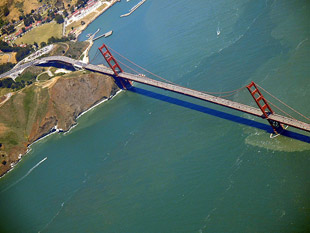 Hans Bakker of the Netherlands told us he would make a good example for AOPA’s Rusty Pilot program. A glider enthusiast, he stopped flying at age 26 with 450 glider hours and 5,000 miles of cross-country competition. Then he got to be 65, and thought maybe touring the United States in a powered airplane would be a good retirement gig.
Hans Bakker of the Netherlands told us he would make a good example for AOPA’s Rusty Pilot program. A glider enthusiast, he stopped flying at age 26 with 450 glider hours and 5,000 miles of cross-country competition. Then he got to be 65, and thought maybe touring the United States in a powered airplane would be a good retirement gig.
The march to the goal began in 2013 when he got a private pilot license in the United States—Florida, to be exact. This year he returned, rented a Cessna 172 SP, and headed off to his adventure.
“A couple of weeks ago I returned home in the Netherlands having flown 8,500 miles, adding 110 hours. My trip took me from Florida to California, Seattle, Salt Lake City, Grand Canyon, Grand Junction, Mount Rushmore, Oshkosh, Niagara Falls, Martha’s Vineyard, New York (Hudson River), Nashville, Atlanta, [and] back to Florida,” Bakker said.
He flew for seven weeks, sightseeing in the air as well as on the ground. “[It] exceeded every expectation and I have enjoyed it very much. Beautiful sights, friendliest people—will remain a lasting memory, helped by the many pictures and Garmin VIRB video I took.” One of the highlights was programming all of the visual flight rules Grand Canyon routes into his GPS and flying each one. The programming took time but made the actual flights simple. He estimates the combined total of getting his private pilot certificate last year, then returning to the United States to fly for seven weeks cost a total of $40,000. While that’s the equivalent of a well-equipped new car, he said it was less expensive than doing the same sort of adventure in Europe.
But what happens now that the goal is attained? Will the rust start to accumulate again?
“The original goal was to do this trip and then decide about what next, but by now I know I will certainly return to the U.S. within a year to do more flying (and this time take my wife with me),” he said.
Email [email protected]
Products: Safe Flight’s new AOA system
Beyond stall avoidance
Dave Hirschman

Safe Flight has developed an angle-of-attack system that does much more than help pilots fly precise approaches and avoid stalls. The company’s SCx is a non-TSO system that also shows the best angles to fly for maximum rate and angle of climb, range, and endurance.
“Our AOA system improves efficiency in all phases of flight,” said Ken Bannon, a pilot for the company founded in 1946 and based in White Plains, New York. “It works the same throughout the full range of aircraft weight and automatically compensates for changes in density altitude.”
Unlike other angle-of-attack sensors that measure differential air pressure, the Safe Flight system gets its information electronically from a tab on the leading edge of the wing. As the angle of attack approaches the “critical angle” at which the wing stalls, the tab—or “lift transducer”—sends information electronically to a tiny computer with a light bar displayed in the pilot’s field of view. Pilots can see at a glance whether their airplane is flying too fast, too slow, or just right for the desired phase of flight.
During a demonstration in Safe Flight’s Cessna 172, the SCx system gave precise indications for best rate of climb, maximum range, and normal and short-field approaches, as well impending stalls in both level and maneuvering flight.
The vertically oriented light bar is less intuitive than other angle-of-attack systems whose chevrons simply command nose-up or nose-down. But once a pilot becomes familiar with the Safe Flight symbols, the AOA system quickly becomes useful in all phases of flight, and not just approaches or stall avoidance.
The Safe Flight SCx system is totally independent of the aircraft pitot/static system. It has a retail price of $1,495 and takes approximately two hours to install.
Email [email protected]
Web: www.safeflight.com


